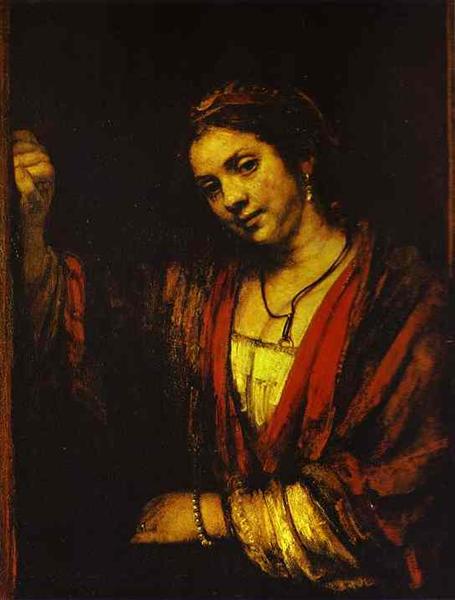Description
Rembrandt's Hendrickje at an Open Door (1656) stands as one of the most moving depictions of the artist's intimate and penetrating personal world. This piece is not only a testament to the painter's technical mastery, but also reveals the deep emotional connection he shared with his model, Hendrickje Stoffels, who was his lover and model at different stages of his life.
The composition depicts Hendrickje in a moment of stillness and contemplation, standing on the threshold of an open door, which acts not only as a physical but also a symbolic frame. The open door suggests a transition, a connection between inside and outside, between the intimacy of the home and the vast world outside. This effect is accentuated by Rembrandt’s skill in playing with light, which illuminates Hendrickje’s face and figure, highlighting her beauty and importance in the scene. Light, a central element in Rembrandt’s work, is manipulated with singular mastery to give life and three-dimensionality to the figure, while suggesting depth in the darkness of the space behind her.
Hendrickje’s clothing, with its soft folds and rich texture, is painted with meticulous attention to detail, allowing the viewer to appreciate the quality of the fabric and the style of the period. The tonality of her attire, a palette that is characteristic of Rembrandt’s art, is rich and warm, blending harmoniously with the darker background, reinforcing the figure’s presence in the space. It is as if the light emanating from her figure illuminates not only her face, but also the pompous, restrained atmosphere of the scene.
Despite the somewhat dark wall behind Hendrickje, her open posture and soft gaze towards the viewer seem to convey a sense of invitation and vulnerability. In this sense, the use of negative space around her allows the focus to remain on her figure, creating an almost mystical aura that invites contemplation and reflection on human intimacy and the gaze towards the loved one.
It is crucial to consider that this work not only encapsulates a moment, but also serves as an emotional portrait of the relationship between the artist and his model. In art history, Rembrandt is known for his ability to convey the humanity of his subjects, and in “Hendrickje at an Open Door” this humanity becomes palpable. The work can be interpreted as a tribute to the uniqueness of its model, a tribute to the intimate connection that existed between the two, reflecting not only the genius of the artist, but also the complexity of human relationships.
Furthermore, her style in this period is distinguished by a more personal and psychological approach compared to her earlier, more formal portraits. This evolution towards the intimate and the everyday allows works like this to resonate with contemporary audiences, showing that vulnerability and sensitivity are universal themes that transcend time and cultural context.
In short, “Hendrickje at an Open Door” is much more than a simple portrait; it is a journey through light and shadow, a dialogue between the viewer and the painter’s intimate world, which manages to capture the essence of humanity in its purest and most direct form. In this work, Rembrandt does not simply depict a woman in a doorway, but invites us to enter the emotional world that he created and shared with her, a reflection on the beauty and fragility of life itself.
KUADROS ©, a famous painting on your wall.
Hand-made oil painting reproductions, with the quality of professional artists and the distinctive seal of KUADROS ©.
Painting reproduction service with satisfaction guarantee. If you are not completely satisfied with the replica of your painting, we will refund 100% of your money.

